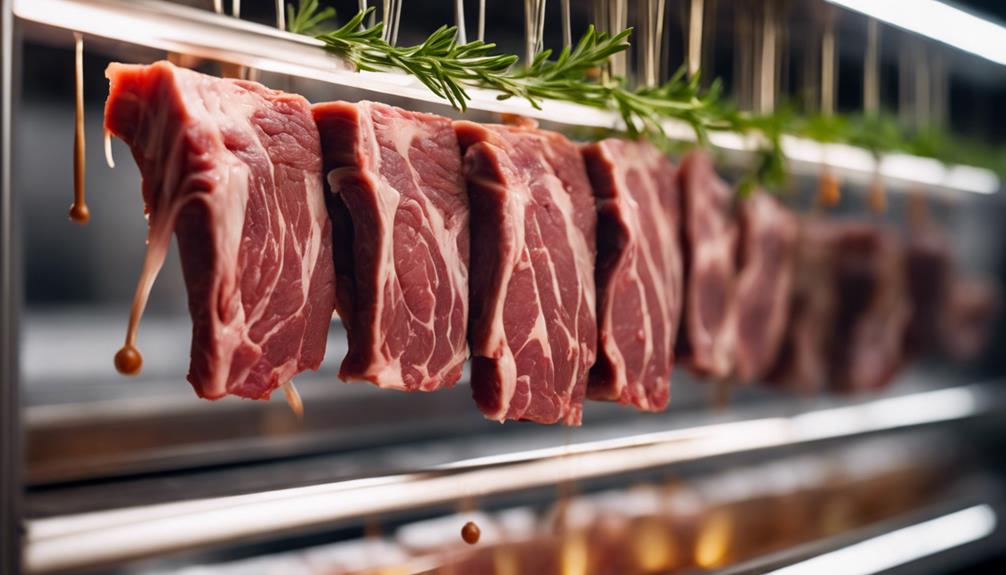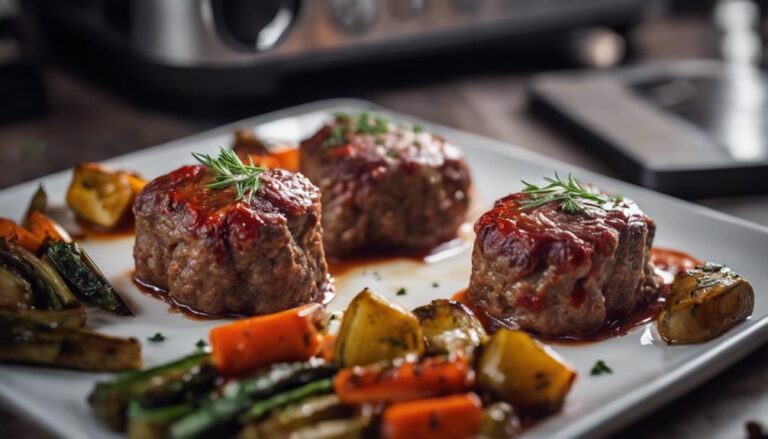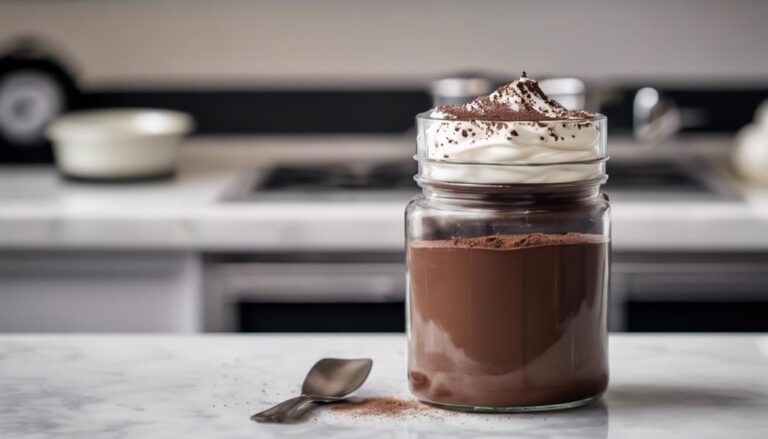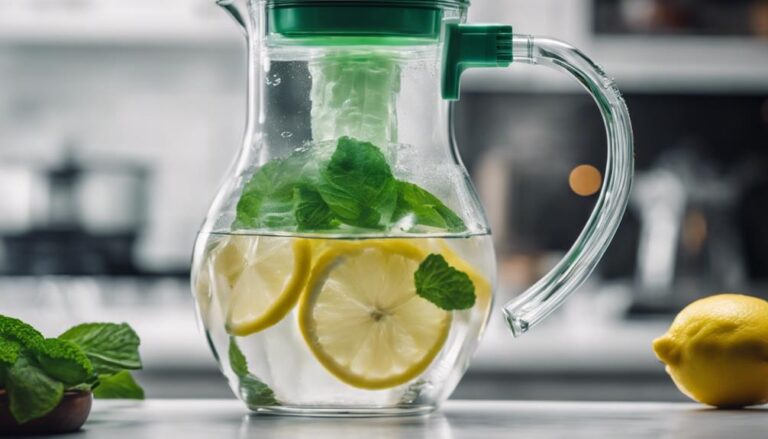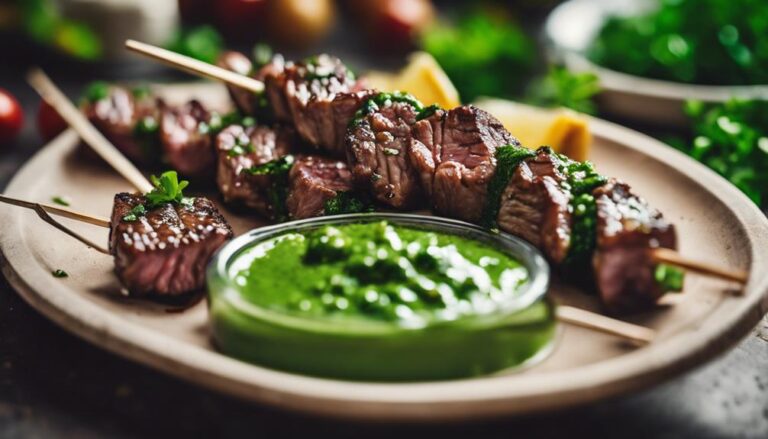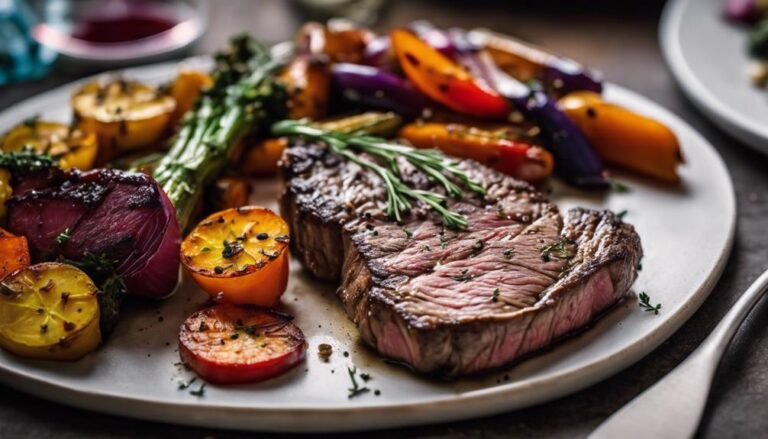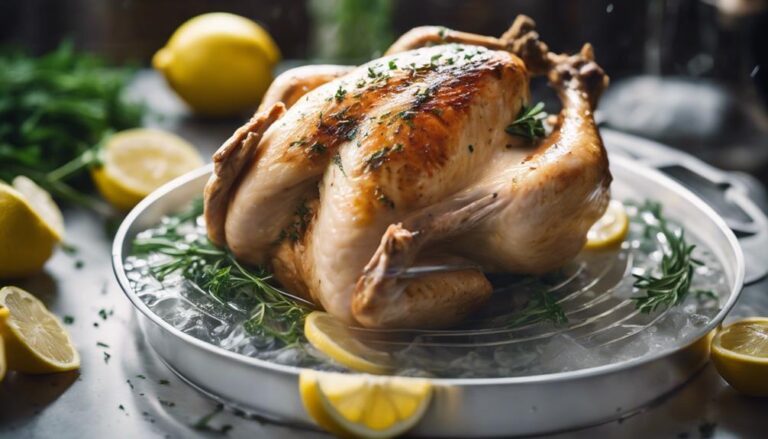Sous Vide Beef Jerky
For succulent sous vide beef jerky, seal seasoned meat in a vacuum bag. Cook in a water bath at the desired temperature for tenderness. This method guarantees juicy jerky with concentrated flavors. After sous vide, finish in an oven or dehydrator for that classic chewy texture. Enhance with diverse seasonings like soy sauce or cayenne pepper. Perfect for snacking or outdoor adventures, sous vide beef jerky elevates your jerky game. Additional information awaits to enrich your jerky-making journey.
What You Will Learn Here
- Sous vide allows precise temperature control for tender, consistent beef jerky.
- Immersing seasoned meat in a vacuum-sealed bag ensures flavor infusion.
- Sous vide method retains moisture, resulting in a juicy jerky texture.
- Extended cooking times at low temperatures break down tough fibers.
- Finish jerky in a dehydrator for the perfect chewy consistency.
Jerky's Origins
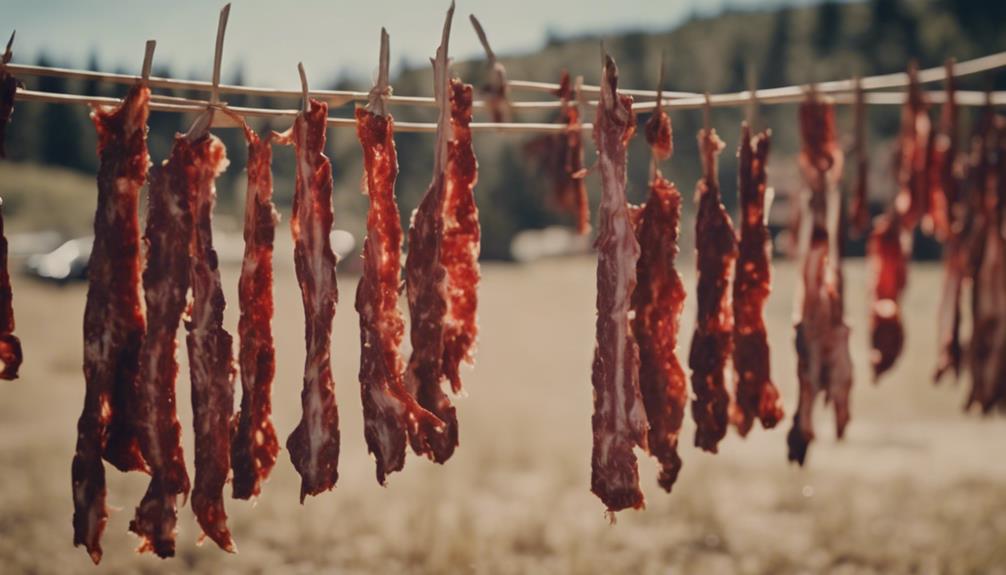
Jerky's origins are deeply rooted in history, tracing back to ancient civilizations where preserving meat was a necessity for survival. Early methods of jerky preparation involved drying and salting meat to prevent spoilage.
Different cultures around the world have their variations of jerky, showcasing the diverse ways in which this preserved meat snack has evolved over time.
Jerky's Historical Roots
With origins tracing back to ancient civilizations, the process of preserving meat through dehydration can be dated as far back as early human history. Jerky's historical roots lie in the need for food preservation in various cultures and climates. Native American tribes, such as the Quechua people in South America, used the technique to store meat for long journeys or harsh winters.
Similarly, traditional African biltong and Chinese bakkwa demonstrate early forms of dried meat. Over time, jerky evolved in historical contexts like the expansion of the American frontier, where pioneers relied on jerky as a portable, long-lasting food source.
Today, jerky has seen modern twists with gourmet flavors, leaner cuts, and diverse preparation methods that cater to contemporary tastes.
Early Jerky Preparation
Exploring the early origins of jerky reveals a fascinating history of meat preservation techniques utilized by various cultures throughout the ages. Early jerky preparation involved thinly slicing lean meat, typically from game animals like deer or bison, to increase surface area for drying.
To prevent spoilage and enhance flavor, ancient civilizations developed marinade techniques using ingredients like salt, vinegar, and various spices. These marinades not only seasoned the meat but also played an essential role in the preservation process by inhibiting bacterial growth.
The marinated meat would then be dried in the sun or over a fire, slowly transforming into the chewy, flavorful jerky we recognize today. This meticulous process ensured that the meat remained edible for extended periods, making it a valuable source of sustenance for ancient nomadic tribes and explorers.
Cultural Jerky Variations
Cultural variations in jerky preparation techniques highlight the diverse methods and flavors originating from different regions and traditions. Jerky preservation methods vary across cultures, with some relying on smoking, dehydration, or curing with salt to extend the meat's shelf life.
For instance, Native American tribes traditionally dried meat over fires or in the sun, while South African biltong involves air-drying the meat with a blend of vinegar, salt, and spices. Jerky marinating techniques also differ widely, with Asian cultures often using soy sauce, sugar, and spices for a savory-sweet flavor, while South American varieties incorporate acidic ingredients like lime juice or vinegar for a tangy taste.
These cultural nuances in jerky preparation contribute to the rich tapestry of flavors found in this beloved snack.
Jerky Flavor Profiles
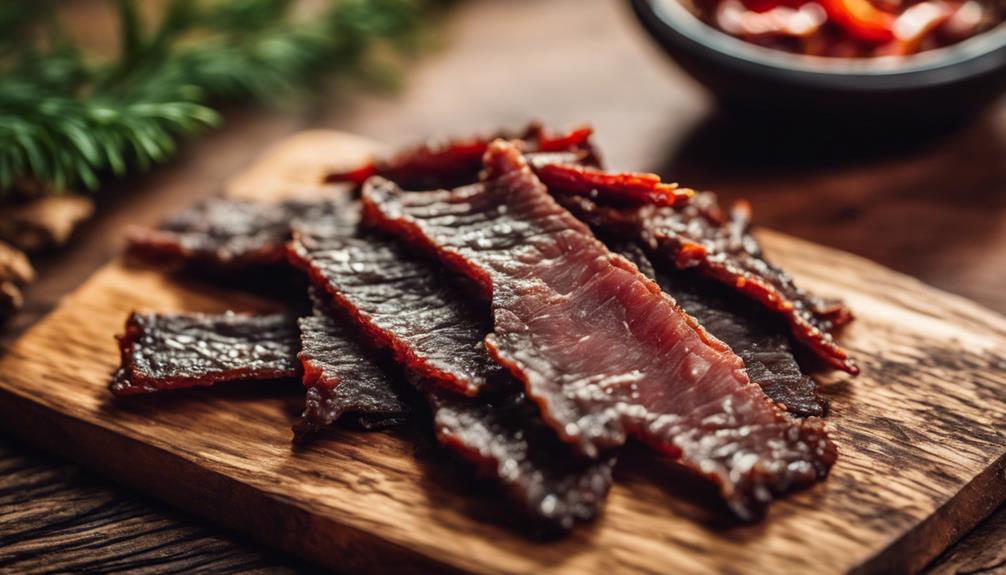
Explore various flavor profiles to enhance your sous vide beef jerky. When crafting your jerky, the flavor profile you choose can make a significant impact on the final product. Here are some options to explore:
- Sweet and Spicy: A combination of brown sugar, soy sauce, and red pepper flakes can create a jerky with a perfect balance of sweetness and heat, appealing to those who enjoy a flavor kick.
- Savory Herb: Utilize a blend of herbs like thyme, rosemary, and garlic powder for a savory jerky that's rich in aromatic flavors, perfect for those who prefer a more traditional taste.
- Teriyaki Twist: Incorporating ingredients like ginger, garlic, and sesame oil can provide a jerky with a sweet and tangy teriyaki flavor, offering a unique and Asian-inspired taste.
- Smokehouse Delight: Infuse your jerky with a smoky flavor by using ingredients like liquid smoke, paprika, and Worcestershire sauce, creating a rustic and bold taste that's reminiscent of traditional smokehouse jerky.
Experimenting with different flavor profiles can help you find the perfect taste that suits your preferences and delights your palate.
Tasty Jerky Variations
Explore a world of flavor with variations such as Savory Teriyaki Beef Jerky, Spicy Buffalo Jerky, and Honey Sriracha Beef Jerky. Each option offers a unique taste experience that can cater to different palates and preferences.
Experimenting with these tasty variations can add excitement and diversity to your jerky-making repertoire.
Savory Teriyaki Beef Jerky
To enhance the flavor profile of your beef jerky, consider marinating thinly sliced beef in a homemade teriyaki sauce before dehydrating it using the sous vide method. This savory teriyaki beef jerky offers a delightful twist to your snack with a perfect balance of sweetness and umami flavors. Here's why you should try it:
- Rich Flavor: The teriyaki marinade infuses the beef with a rich, savory taste that will leave your taste buds wanting more.
- Tender Texture: The sous vide method guarantees the beef jerky is perfectly tender and juicy, unlike traditional dehydrating methods.
- Customizable Seasonings: You can adjust the seasonings in the teriyaki sauce to suit your taste preferences.
- Quality Ingredients: Using high-quality beef and homemade teriyaki sauce promises a gourmet jerky experience.
Spicy Buffalo Jerky
Enhance your jerky-making repertoire with a fiery kick by diving into the world of Spicy Buffalo Jerky, a tantalizing twist on traditional beef jerky flavors. To create this mouth-watering treat, follow these steps:
- Prepare the Buffalo Marinade: Blend hot sauce, Worcestershire sauce, garlic powder, and onion powder to marinate the beef strips.
- Seasoning Sensation: Coat the marinated beef with a spicy seasoning mix of cayenne pepper, paprika, and a hint of brown sugar for that perfect balance of heat and sweetness.
- Slow Marination: Allow the beef to marinate in the Buffalo sauce for at least 12 hours to absorb all the flavors.
- Dehydrate to Perfection: Dehydrate the marinated beef slices until they achieve the perfect chewy texture, locking in the Spicy Buffalo Jerky's bold flavors.
Honey Sriracha Beef Jerky
For a delectable twist on traditional beef jerky flavors, explore the world of Honey Sriracha Beef Jerky, blending the perfect balance of sweetness and heat in each savory bite.
- Bold Flavor: The honey sriracha marinade infuses the beef with a bold and irresistible flavor profile.
- Sweet Heat: Experience the harmonious combination of sweet and spicy notes that tantalize your taste buds.
- Tender Texture: The sous vide cooking method guarantees a tender texture that melts in your mouth with every chew.
- Addictive Snack: Once you try this honey sriracha beef jerky, you won't be able to resist coming back for more of its addictive sweet heat flavor.
Jerky Texture Enhancement
To enhance the texture of your jerky, focus on techniques such as:
- Adjusting the thickness of your meat slices
- Experimenting with different marinades for flavor infusion
- Controlling moisture levels during the cooking process
These points are essential to achieving the desired chewiness and tenderness in your jerky. By carefully considering these aspects, you can elevate the overall quality of your homemade beef jerky.
Texture Enhancement Tips
Consider experimenting with different marinades and seasonings to elevate the texture of your beef jerky. Texture experimentation can involve varying the thickness of your meat slices, adjusting the cooking time, or exploring different seasoning combinations.
For a chewier texture, try slicing the meat against the grain or marinating it longer to break down the muscle fibers. Cooking techniques play a significant role in texture; consider adjusting the sous vide temperature or time to achieve your desired consistency.
Additionally, incorporating ingredients like soy sauce or Worcestershire sauce can enhance the umami flavor and tenderize the meat. By fine-tuning your marinades, cooking methods, and seasonings, you can achieve a jerky texture that's both satisfying and delicious.
Flavor Infusion Techniques
How can you enhance the texture of your beef jerky through flavor infusion techniques?
Marinade infusion and seasoning techniques are key methods to elevate the taste and texture of your jerky.
Marinade infusion involves marinating the beef slices in a flavorful liquid mixture, allowing the meat to absorb the seasonings and tenderize. This process not only imparts depth of flavor but also helps break down the muscle fibers for a more tender texture.
Seasoning techniques play an essential role in enhancing the overall taste profile of the jerky. By carefully selecting and applying a blend of spices, herbs, and seasonings, you can create a well-balanced and robust flavor that complements the natural richness of the beef.
These methods work together to ensure your beef jerky is bursting with delicious flavor and has a satisfying texture.
Moisture Control Methods
For ideal texture enhancement in your beef jerky, managing moisture levels is vital to achieve the desired chewiness and shelf stability. When controlling moisture, utilizing dehydration techniques is essential.
After marinating your beef strips in flavorful marinade recipes, make sure excess moisture is removed before the drying process. Patting the strips dry with paper towels or a clean cloth helps in this regard. Additionally, using a dehydrator set at the recommended temperature aids in eliminating moisture effectively.
Regularly monitoring the dehydration progress is key to prevent over-drying, which can make the jerky too tough. By carefully controlling moisture levels through proper dehydration techniques, you can achieve perfectly textured beef jerky that's both chewy and long-lasting.
Final Thoughts
In conclusion, reflecting on the process of making Sous Vide Beef Jerky reveals the meticulous attention to detail required for achieving the perfect balance of flavor and texture. When considering storage tips, it's important to store your beef jerky in airtight containers or vacuum-sealed bags to maintain its freshness. Experimenting with different flavors such as teriyaki, spicy sriracha, or smoky mesquite can add variety to your jerky-making experience.
Proper jerky packaging is vital for extending the shelf life of your Sous Vide Beef Jerky. Make sure that the packaging is airtight and moisture-proof to prevent spoilage. Vacuum sealing is highly recommended for preserving the jerky's quality over time. Additionally, storing the jerky in a cool, dry place away from direct sunlight will help maintain its taste and texture.
Frequently Asked Questions
Can I Use a Regular Oven Instead of a Sous Vide Machine?
Yes, you can use a regular oven as an alternative method. For best results, choose lean cuts of meat, employ low and slow cooking techniques, and monitor temperature carefully. Adjust cooking time to achieve the desired texture in your beef jerky.
How Long Does Sous Vide Beef Jerky Last?
To extend shelf life, store properly in airtight containers. Keep jerky in a cool, dry place for best results. Flavor variations can arise from different drying methods used. Experiment with seasonings and marinades to enhance taste.
Is It Safe to Consume Raw Beef Jerky?
When considering food safety and preservation, consuming raw beef jerky is not recommended. Raw meat carries the risk of harmful bacteria. To guarantee safety, always follow proper cooking methods to eliminate any potential health risks.
Can I Add Alcohol to the Marinade for Flavor?
You can add alcohol to marinades for flavor enhancement. Alcohol infusion can impart unique tastes to your dishes. Experiment with different types of alcohol like bourbon, wine, or rum to find the perfect complement to your recipe.
What Are the Best Cuts of Beef for Making Jerky?
For making jerky, focus on meat selection for peak flavor profiles. Consider texture preference when choosing cuts like top round, flank steak, or sirloin. Experiment with drying methods to achieve desired results.
Conclusion
To sum up, sous vide beef jerky offers a convenient and delicious way to enjoy this popular snack. By using precise temperature control and extended cooking times, you can achieve the perfect texture and flavor profile every time.
Experimenting with different marinades and seasonings allows for endless variations to suit your taste preferences. Whether you prefer sweet, spicy, or savory jerky, sous vide cooking provides a foolproof method for creating the ultimate beef jerky experience.
